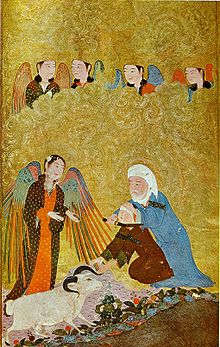
Back Цімурыдскае мастацтва Byelorussian Тымурыдзкае мастацтва BE-X-OLD Тимуридско изкуство Bulgarian Arte timúrida Spanish Art timouride French Kesenian Timuriyah ID Arte timuride Italian Тимуридское искусство Russian ටිමූරීය කලාව Singhalese Timurlu Sanatı Turkish

Timurid art is a style of art originating during the rule of the Timurid Empire (1370-1507) and was spread across Iran and Central Asia. Timurid art was noted for its usage of both Persian and Chinese styles, as well as for taking influence from the art of other civilizations in Central Asia.[1] Scholars regard this time period as an age of cultural and artistic excellence. After the decline of the Timurid Empire, the art of the civilization continued to influence other cultures in West and Central Asia.[1][2]
Considered a rich period of Persian artistic revival, Timurid art can be characterized by an emphasis on book arts and manuscript illumination as well as luxury arts like metalwork and jade carving.[1] Architecturally, the Timurids had ambitious building programs, most often building Sufi shrines, khanqas, mosques, and madrasas.[1][3]
- ^ a b c d Komaroff, Authors: Suzan Yalman, Linda. "The Art of the Timurid Period (ca. 1370–1507) | Essay | Heilbrunn Timeline of Art History | The Metropolitan Museum of Art". The Met’s Heilbrunn Timeline of Art History. Retrieved 2017-11-16.
{{cite web}}: CS1 maint: multiple names: authors list (link) - ^ Cite error: The named reference
:2was invoked but never defined (see the help page). - ^ Irwin, Robert (1997). Islamic art in context : art, architecture, and the literary world. Upper Saddle River, NJ. ISBN 0-13-599812-3. OCLC 36029669.
{{cite book}}: CS1 maint: location missing publisher (link)
© MMXXIII Rich X Search. We shall prevail. All rights reserved. Rich X Search